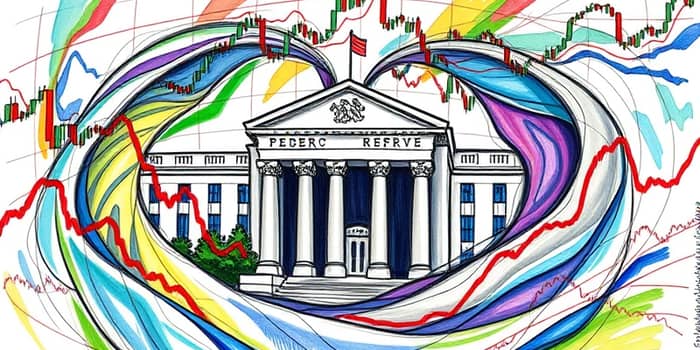In the aftermath of a volatile rate cycle spanning 2023 and 2024, investors are grappling with profound shifts in valuation and capital flows. Central bank decisions now carry more weight than ever before, shaping both equity returns and bond yields.
As the benchmark 10-year Treasury yield oscillated from near 5% in late 2023 to 3.63% by September 2024, debate has surged around the inverse relationship between rates and equities. This article unpacks the mechanics, historical trends, and strategic responses relevant to today’s financial landscape.
How Interest Rates Influence Stocks
Interest rates serve as the backbone of modern markets. When the Federal Reserve raises its policy rate, borrowing costs for companies and consumers climb. Higher debt servicing expenses can compress margins and dampen profitability.
Conversely, rate cuts often lead to expansionary phases, where cheaper credit fuels investment and consumption. The mechanics can be summarized succinctly:
- A rise in rates increases the cost of capital for businesses, reducing earnings potential.
- A fall in rates enhances investment returns, boosting share prices over time.
Yet, this relationship is not ironclad. Periods of strong economic expansion have coincided with rising rates and bullish equity performance, especially when driven by robust economic growth and corporate earnings.
Bond Market Dynamics
The bond market reacts to interest rate changes through price adjustments. When yields go up, existing bonds with lower coupons drop in price to match new issues. In declining rate environments, the reverse happens.
This dynamic highlights the sensitivity of longer-term bonds. Duration measures help quantify how much a bond’s price moves in response to yield shifts.
- Higher interest rates lead to price declines for existing bonds.
- Lower interest rates boost the value of outstanding bonds.
Investors must weigh yield opportunities against price risk, particularly in bond ladder strategies and duration-managed portfolios.
Macroeconomic Feedback Loops and the Fed’s Mandate
The Federal Reserve juggles two objectives: promoting maximum employment and stabilizing prices. Tightening cycles aim to cool inflation but can slow hiring and growth. Easing cycles risk stoking excessive price gains.
The interplay between employment data, inflation readings, and rate policy creates complex feedback loops. Market participants monitor speeches, minutes, and economic releases for hints of future rate pivots.
In this context, interest rates are more than a cost metric—they are a barometer of economic confidence and central bank credibility.
Current Data Spotlight
By the close of 2024, elevated rates have led many analysts to label U.S. equities as overvalued relative to historical norms. Below is a snapshot of key metrics:
This data underscores the current equity overvaluation relative to bonds and highlights potential correction risks if rates remain high.
Contrarian Scenarios
While conventional wisdom suggests that rising rates punish stocks, exceptions abound. When growth surges faster than anticipated, robust corporate earnings can offset higher financing costs.
Geopolitical stability, technological innovation, or a stronger-than-expected labor market can also drive a scenario where higher yields on savings and fixed-income coexist with stock market rallies.
Such episodes remind investors that no single indicator guarantees outcomes; context and driver analysis are key.
Investor Strategies for Evolving Rate Cycles
Adapting to shifting rate environments requires both discipline and flexibility. Below are strategic considerations:
- Maintain diversification across asset classes to buffer against unexpected rate moves.
- Consider bond ladders or floating-rate instruments to mitigate duration risk.
- Reassess equity valuations regularly, aligning holdings with updated yield expectations.
- Monitor the yield curve for signs of recessionary pressure or growth optimism.
By blending quantitative models with qualitative insights, investors can position portfolios to navigate both restrictive and accommodative policy phases.
Conclusion: Staying Vigilant in Uncertain Times
Interest rates will remain a central force in market performance, influencing valuations, capital allocation, and investor psychology. Continuous monitoring of rate trends, central bank communications, and economic indicators is essential for informed decision-making.
Ultimately, understanding the mechanisms at play—from bond price sensitivity to the trade-off between inflation control and growth—equips market participants with the tools needed to thrive.
As the global economy evolves, the relationship between rates and markets will continue to shape opportunities and risks. Staying informed and adaptable is the path to sustainable success.
References
- https://www.usbank.com/investing/financial-perspectives/market-news/how-do-rising-interest-rates-affect-the-stock-market.html
- https://www.investopedia.com/articles/stocks/09/how-interest-rates-affect-markets.asp
- https://www.currentmarketvaluation.com/models/10y-interest-rates.php
- https://home.treasury.gov/policy-issues/financing-the-government/interest-rate-statistics
- https://www.investopedia.com/investing/how-interest-rates-affect-stock-market/
- https://www.sba.gov/business-guide/plan-your-business/market-research-competitive-analysis
- https://www.investopedia.com/terms/s/stockmarket.asp










